
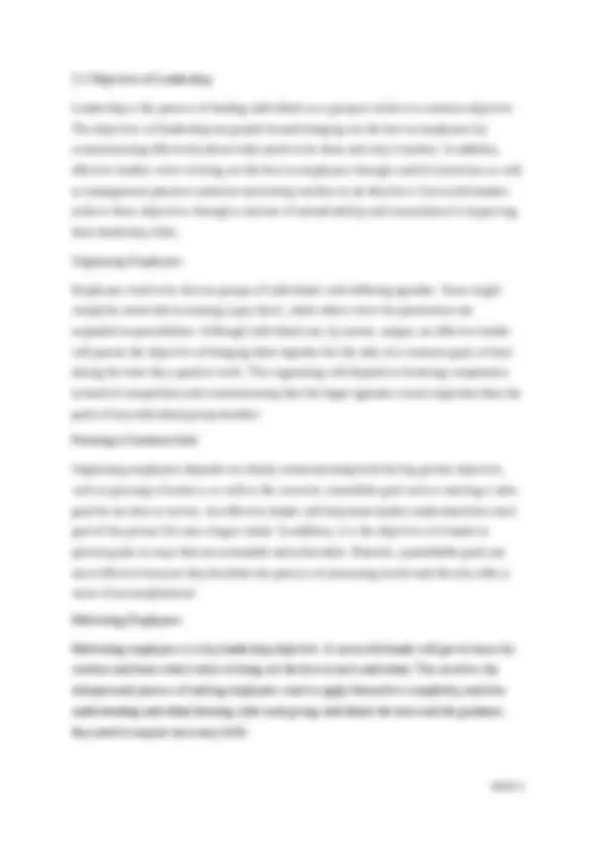

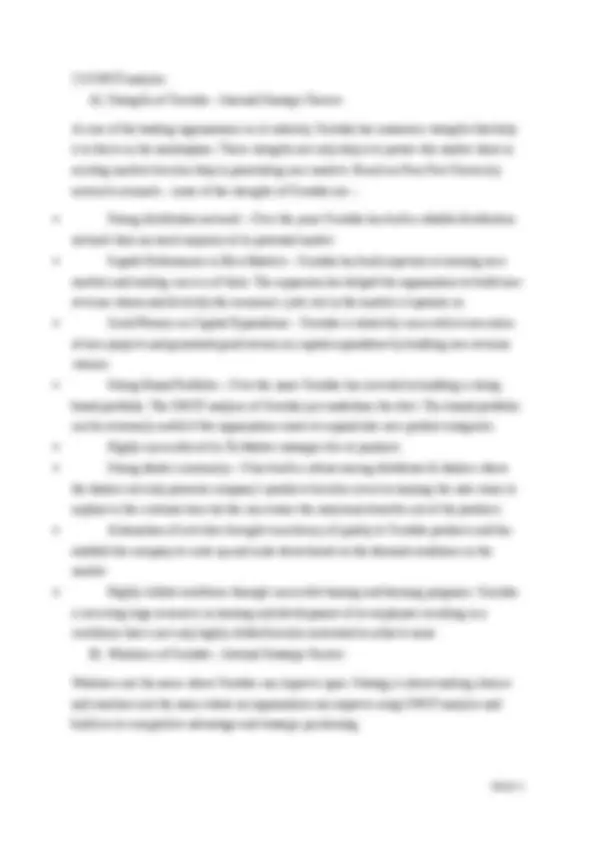
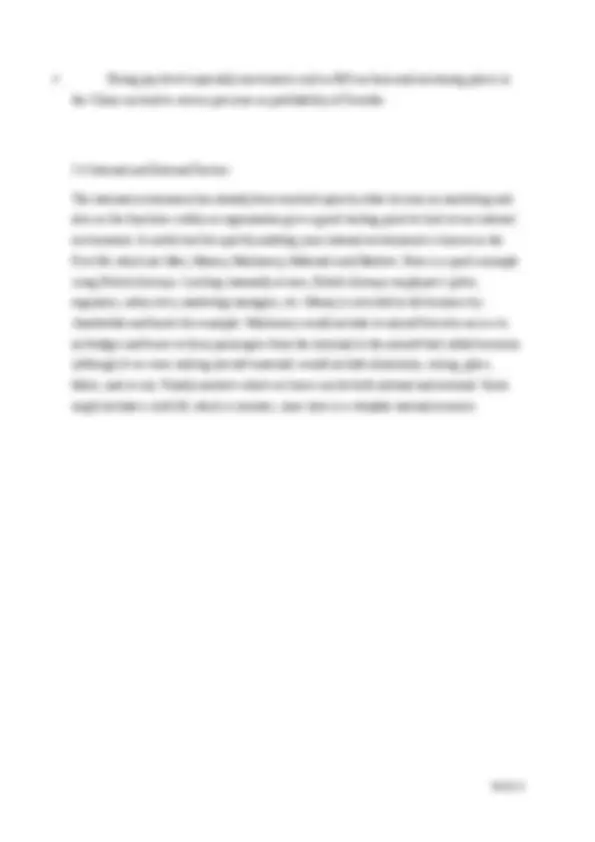
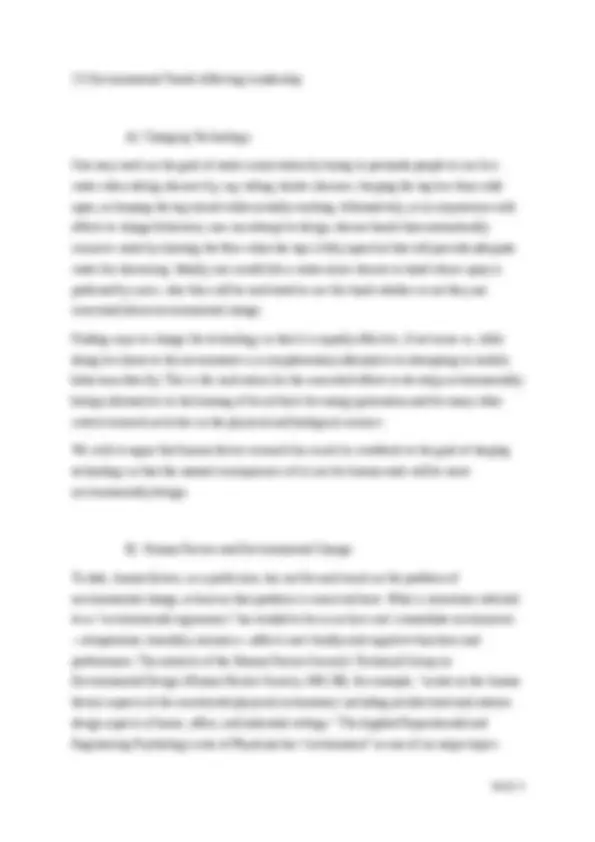
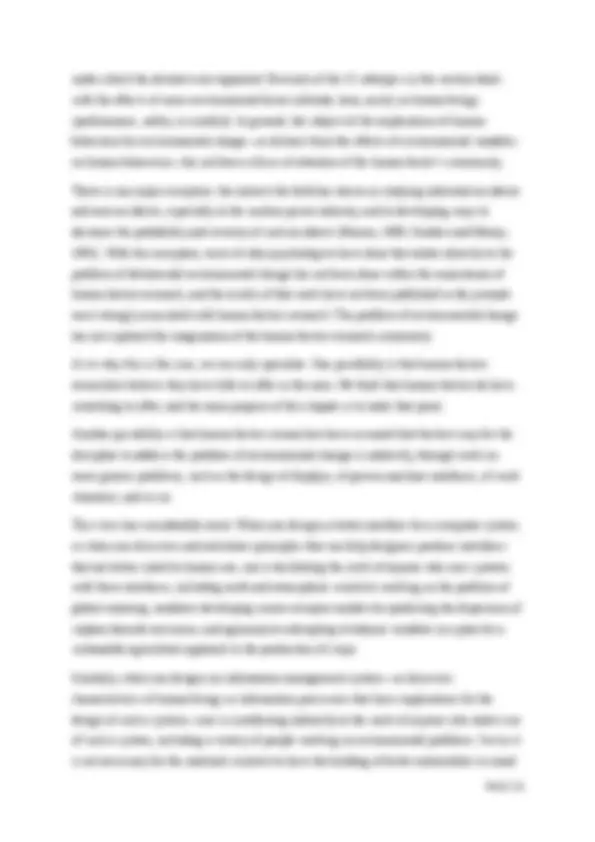
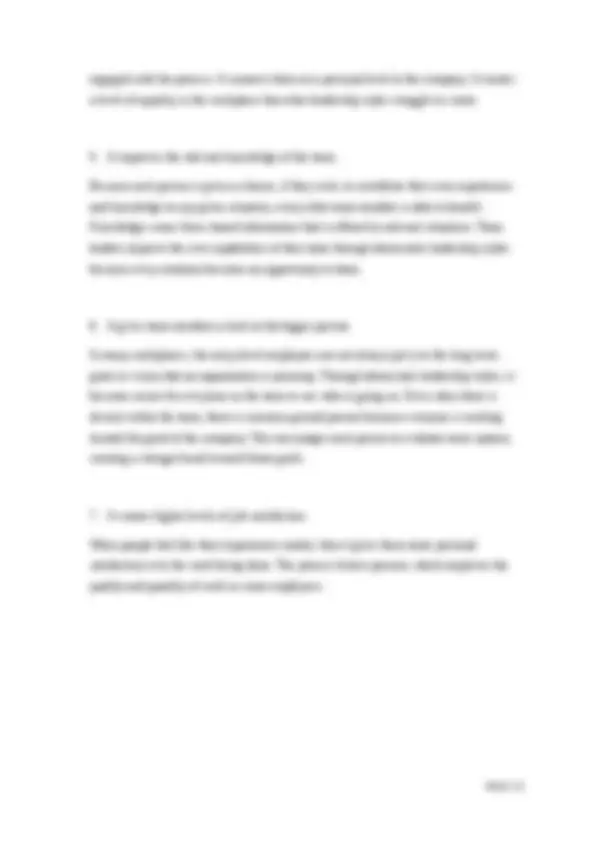
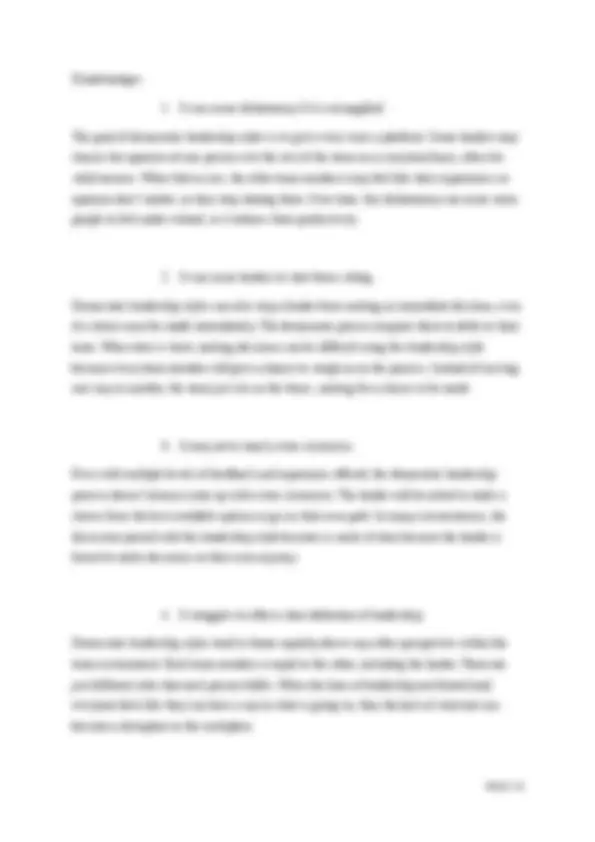



Study with the several resources on Docsity

Earn points by helping other students or get them with a premium plan


Prepare for your exams
Study with the several resources on Docsity

Earn points to download
Earn points by helping other students or get them with a premium plan
Community
Ask the community for help and clear up your study doubts
Discover the best universities in your country according to Docsity users
Free resources
Download our free guides on studying techniques, anxiety management strategies, and thesis advice from Docsity tutors
OTHM LEVEL 7 DIPLOMA IN STRATEGIC MANAGEMENT AND LEADERSHIP
Typology: Schemes and Mind Maps
1 / 15

This page cannot be seen from the preview
Don't miss anything!










2.0 leadership management team What is leadership? A simple definition is that leadership is the art of motivating a group of people to act toward achieving a common goal. In a business setting, this can mean directing workers and colleagues with a strategy to meet the company's needs. This leadership definition captures the essentials of being able and prepared to inspire others. Effective leadership is based upon ideas (whether original or borrowed) but won't happen unless those ideas can be communicated to others in a way that engages them enough to act as the leader wants them to act. Put even more simply, the leader is the inspiration for and director of the action. They are the person in the group that possesses the combination of personality and leadership skills to make others want to follow their direction.
2.2 Vision and Mission of Leadership Vision: Defines the desired or intended future state of a specific organization or enterprise in terms of its fundamental objective and/or strategic direction. Vision is a long-term objective. Mission: Defines the fundamental purpose of an organization or an enterprise, describing why it exists. Mission is a short-term objective.
2.3 SWOT analysis A) Strengths of Youtube – Internal Strategic Factors As one of the leading organizations in its industry, Youtube has numerous strengths that help it to thrive in the marketplace. These strengths not only help it to protect the market share in existing markets but also help in penetrating new markets. Based on Fern Fort University extensive research – some of the strengths of Youtube are – Strong distribution network – Over the years Youtube has built a reliable distribution network that can reach majority of its potential market. Superb Performance in New Markets – Youtube has built expertise at entering new markets and making success of them. The expansion has helped the organization to build new revenue stream and diversify the economic cycle risk in the markets it operates in. Good Returns on Capital Expenditure – Youtube is relatively successful at execution of new projects and generated good returns on capital expenditure by building new revenue streams. Strong Brand Portfolio – Over the years Youtube has invested in building a strong brand portfolio. The SWOT analysis of Youtube just underlines this fact. This brand portfolio can be extremely useful if the organization wants to expand into new product categories. Highly successful at Go To Market strategies for its products. Strong dealer community – It has built a culture among distributor & dealers where the dealers not only promote company’s products but also invest in training the sales team to explain to the customer how he/she can extract the maximum benefits out of the products. Automation of activities brought consistency of quality to Youtube products and has enabled the company to scale up and scale down based on the demand conditions in the market. Highly skilled workforce through successful training and learning programs. Youtube is investing huge resources in training and development of its employees resulting in a workforce that is not only highly skilled but also motivated to achieve more. B) Weakness of Youtube – Internal Strategic Factors Weakness are the areas where Youtube can improve upon. Strategy is about making choices and weakness are the areas where an organization can improve using SWOT analysis and build on its competitive advantage and strategic positioning.
products segments. This should open a window of opportunity for Youtube in other product categories. New customers from online channel – Over the past few years the company has invested vast sum of money into the online platform. This investment has opened new sales channel for Youtube. In the next few years, the company can leverage this opportunity by knowing its customer better and serving their needs using big data analytics. The new taxation policy can significantly impact the way of doing business and can open new opportunity for established players such as Youtube to increase its profitability. Decreasing cost of transportation because of lower shipping prices can also bring down the cost of Youtube’s products thus providing an opportunity to the company - either to boost its profitability or pass on the benefits to the customers to gain market share. New trends in the consumer behavior can open up new market for the Youtube. It provides a great opportunity for the organization to build new revenue streams and diversify into new product categories too. The new technology provides an opportunity to Youtube to practices differentiated pricing strategy in the new market. It will enable the firm to maintain its loyal customers with great service and lure new customers through other value-oriented propositions. Threats Youtube Facing - External Strategic Factors Intense competition – Stable profitability has increased the number of players in the industry over last two years which has put downward pressure on not only profitability but also on overall sales. New environment regulations under Paris agreement (2016) could be a threat to certain existing product categories. Rising raw material can pose a threat to the Youtube profitability. As the company is operating in numerous countries it is exposed to currency fluctuations especially given the volatile political climate in number of markets across the world. The company can face lawsuits in various markets given - different laws and continuous fluctuations regarding product standards in those markets. Increasing trend toward isolationism in the American economy can lead to similar reaction from other government thus negatively impacting the international sales. Imitation of the counterfeit and low-quality product is also a threat to Youtube’s product especially in the emerging markets and low-income markets.
Rising pay level especially movements such as $15 an hour and increasing prices in the China can lead to serious pressure on profitability of Youtube 2.4 Internal and External Factors The internal environment has already been touched upon by other lessons on marketing and also on the functions within an organization give a good starting point to look at our internal environment. A useful tool for quickly auditing your internal environment is known as the Five Ms which are Men, Money, Machinery, Materials and Markets. Here is a quick example using British Airways. Looking internally at men, British Airways employees’ pilots, engineers, cabin crew, marketing managers, etc. Money is invested in the business by shareholder and banks for example. Machinery would include its aircraft but also access to air bridges and buses to ferry passengers from the terminal to the aircraft fuel called kerosene (although if we were making aircraft materials would include aluminium, wiring, glass, fabric, and so on). Finally markets which we know can be both internal and external. Some might include a sixth M, which is minutes, since time is a valuable internal resource.
under which the abstracts are organized. But each of the 12 subtopics in this section deals with the effects of some environmental factor (altitude, heat, noise) on human beings (performance, safety, or comfort). In general, the subject of the implications of human behaviour for environmental change—as distinct from the effects of environmental variables on human behaviour—has not been a focus of attention of the human factor’s community. There is one major exception: the interest the field has shown in studying industrial accidents and near accidents, especially in the nuclear power industry, and in developing ways to decrease the probability and severity of such accidents (Reason, 1990; Senders and Moray, 1991). With this exception, most of what psychologists have done that relates directly to the problem of detrimental environmental change has not been done within the mainstream of human factors research, and the results of that work have not been published in the journals most strongly associated with human factors research. The problem of environmental change has not captured the imagination of the human factors research community. As to why this is the case, we can only speculate. One possibility is that human factors researchers believe they have little to offer in this area. We think that human factors do have something to offer, and the main purpose of this chapter is to make that point. Another possibility is that human factors researchers have assumed that the best way for the discipline to address the problem of environmental change is indirectly, through work on more generic problems, such as the design of displays, of person-machine interfaces, of work situations, and so on. This view has considerable merit. When one designs a better interface for a computer system, or when one discovers and articulates principles that can help designers produce interfaces that are better suited to human use, one is facilitating the work of anyone who uses systems with these interfaces, including earth and atmospheric scientists working on the problem of global warming, modelers developing source-receptor models for predicting the dispersion of sulphur dioxide emissions, and agronomists attempting to balance variables in a plan for a sustainable-agriculture approach to the production of crops. Similarly, when one designs an information-management system—or discovers characteristics of human beings as information processors that have implications for the design of such a system—one is contributing indirectly to the work of anyone who makes use of such a system, including a variety of people working on environmental problems. Just as it is not necessary for the materials scientist to have the building of better automobiles in mind
in order to affect the automotive industry—by, for example, developing a new lightweight superstring composite—one need not focus explicitly on the environment in order to have a beneficial impact on work on environmental problems. This being said, we believe it is important to raise the question of whether there are opportunities for the human factors community to make more direct and explicit contributions to work on the problem of environmental change than it has done in the past. A major purpose of this chapter is to stimulate thought and discussion about this question. C) Telecommuting and Teleconferencing Telecommunications technology has the potential to make it possible for more people to work, at least part of the time, from their homes rather than commute to offices. It also has the potential, via teleconferencing facilities, to reduce the need for travel to meetings. Although these possibilities were recognized by the earliest promoters of teleconferencing and telecommuting (Favelas et al., 1963; Niles et al., 1976), they have not yet been realized as much as might have been expected. Why that is so is not entirely clear, but there can be no doubt that many human factors issues are involved in the question of how to make these technologies attractive and effective from the user's point of view.
engaged with the process. It connects them on a personal level to the company. It creates a level of equality in the workplace that other leadership styles struggle to create.
Disadvantages